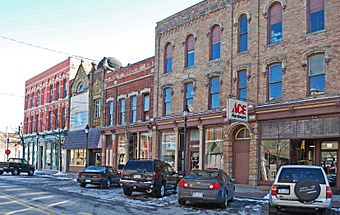Midland Street Commercial District facts for kids
Quick facts for kids |
|
|
Midland Street Commercial District
|
|

SW Corner of Midland and Walnut
|
|
| Location | Roughly bounded by John, Vermont, Catherine and Litchfield Sts., Bay City, Michigan |
|---|---|
| Area | 9 acres (3.6 ha) |
| Architectural style | Colonial Revival, Late Victorian, Art Deco |
| NRHP reference No. | 82002827 |
| Added to NRHP | April 22, 1982 |
The Midland Street Commercial District is a special historic area in Bay City, Michigan. It's filled with old shops and buildings along Midland Street, between Catherine and Litchfield Streets. This district was added to the National Register of Historic Places in 1982 because of its important history.
Contents
Discovering Midland Street's Past
The west side of Bay City grew much later than the east side. People started settling the east side in the late 1830s. But it wasn't until 1863 that big changes came to the west side.
How Wenona Grew into a Busy Town
In 1863, Henry Sage and Henry McGraw built a sawmill on the west side. They created a small town called Wenona and started selling land. The town grew very fast!
By 1865, new roads were built, including one to Midland and another to Saginaw. The Third Street Bridge also connected Wenona to Bay City. By 1866, Wenona had over 1,000 people living there. A railroad line was added in 1867, and the first brick building on Midland Street was built. Wenona and Midland Street quickly became a busy center for trains and businesses.
Changes and Challenges for Midland Street
Around the early 1900s, the lumber industry, which was a main source of money, started to slow down. In 1903, the west side of the river became part of Bay City. This caused businesses to slowly move to the east side of the river.
Growth on Midland Street became very slow during the early 1900s. It stopped completely when the Great Depression began. Because of this, the buildings and look of Midland Street are still very similar to how they were in 1929.
Exploring the Midland Street District
The Midland Street Commercial District stretches for four blocks. It has fifty buildings, and forty-nine of them are two or three stories tall. Most of these buildings were used for shops and businesses.
Forty-four of these buildings help show the historic character of the area. The buildings were built between the 1860s and 1929. You can see different styles of architecture, like Queen Anne, Romanesque Revival, and Art Deco.
Notable Buildings in the District
Here are some of the interesting buildings you can find in the district:
- The Loose Block (601-603 Midland Street): Built in 1879, this three-story building shows the Queen Anne style. It has cool details made from stone, tile, and brick. It was built for William Loose, who made caskets and was an undertaker.
- The Lumberman's State Bank (701 Midland Street): Spencer O. Fisher and Captain James Davidson started this bank. In 1881, they built this three-story brick building for the bank.
- The Fisher Block (705-7-9-13 Midland Street): A fire destroyed the old buildings here in 1881. So, in 1883, Spencer O. Fisher built this large building in the Italianate style.
- The Lewis Block (510-512 Midland Street): This two-story building was constructed around 1890.
- The Westown Theater (611 Midland Street): This theater was built in 1915. It has an Art Deco design and stands where an older business building used to be.
- The People's National Bank (509 Midland Street): This two-story red brick building was built in 1923. It has a Georgian Revival style and was first known as the Bay County Savings Bank.
Gallery





